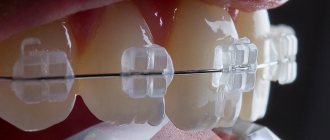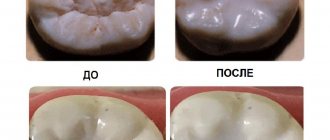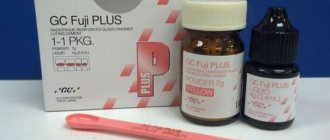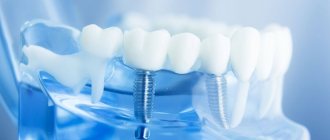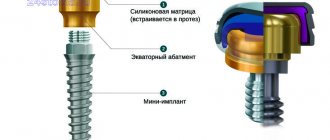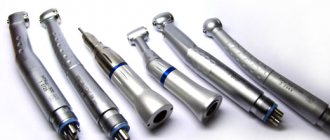The search for new high-quality materials for filling damaged teeth has been going on, perhaps, throughout the entire history of the development of dentistry. Dental clinics are gradually abandoning the crumbling and short-lived dental cements that were used to fill the teeth of our grandmothers and great-grandmothers - because they have been replaced by the latest photopolymer materials. Why a light polymerization filling is good, what kind of material it is - every person should know, because few people in life manage to avoid the filling procedure.
What are the features of light seals?
Briefly, the algorithm for using photopolymer materials in dentistry is as follows. First, the cavity that will be filled with a filling is washed and treated with an adhesive (a liquid that will act as a “gluing” substance for the filling). Then the filling material itself is introduced and shaped as needed in a particular case (to close a hole, restore a chipped enamel, etc.). After this, the dentist shines a polarizing LED lamp on the filling site, and the material hardens. The final touch is mechanical sanding to make it smooth.
What is a light curing filling? This is a material consisting of three components:
- Polymer matrix. This is the component that turns into a solid state under the influence of ultraviolet rays.
- Filler. These are initially solid particles that simply add volume to the filling - like gravel in concrete.
- An additional bonding substance that holds together both the tooth enamel with the filling and the solid particles in the filling.
How is a light seal different from a regular one? On the practical side - the hardening time: the patient leaves the VivaDent clinic with a completely hardened filling, in the form in which it will remain forever. With a light seal you can eat and drink - literally right outside the doors of the dental office.
For a dentist, photopolymer has a lot of advantages when working with it.
- This material does not crumble after hardening. Thanks to this property, it is possible to carry out turning and grinding - both immediately after filling, so that the restored tooth is smooth, and after any amount of time: say, if the tooth needs to be prepared for a crown or veneer. In addition, the ground filling has the same texture as natural enamel, so photopolymer material is also used for filling front teeth.
- Light fillings differ from regular fillings in that they are available in an assortment of shades that accurately imitate tooth enamel - therefore they look very natural if the shade is chosen correctly.
- When filling, an adhesive is used, which firmly binds the hard tissues of the tooth and the filling. Therefore, the durability of such a filling is very long - it can last for five or more years.
- An ultraviolet lamp is used for hardening - no other impact will cause the material to harden, so the dentist can confidently and calmly form the filling, without fear that the material will begin to harden ahead of time from contact with air.
- If such a previously placed filling is damaged (i.e., a piece breaks off, for example, as a result of an impact), it can be restored without completely removing the remains of the old filling from the tooth, but by reshaping the missing part.
Medical Internet conferences
Selecting a Dental Curing Light for Filtek Ultimate Light Curing Composite Material
Burkova A.A., Shcherbakova S.B.
Scientific supervisors: Ph.D., ass. Savina E.A., ass. Aslanyan M.A.
Federal State Budgetary Educational Institution of Higher Education Saratov State Medical University named after. IN AND. Razumovsky Ministry of Health of the Russian Federation
Department of Propaedeutics of Dental Diseases
Filtek Ultimate (3M ESPE) is a new generation light-curing composite filling material. It is used for filling carious cavities of all groups of teeth, forming a stump for an orthopedic structure, and restoring teeth. To obtain a complete and high-quality result, each layer must be polymerized separately using a halogen or LED lamp with a light range of 400-500 nm.
Objective: To compare the efficiency, advantages and disadvantages of halogen and LED lamps based on a literature review.
Halogen curing lamps work by using electrical energy to heat a tungsten filament to a white color. For polymerization, 0.5-0.7% of the generated light is sufficient, and the rest of it is dissipated in the form of heat. The range of light passing through the filter is 400-500 nm, and efficiency = 2-4%. The leading disadvantages of these lamps are: overheating of tooth tissues, long polymerization time (20-40s); vibration and noise of the device; change the filter once a year; frequent replacement of the incandescent lamp; high power consumption. The advantages include a wide radiation spectrum and the possibility of polymerization of composite materials with a photoinitiator other than camphorquinone.
LED lamps based on LEDs generate light with a range of 60 nm using the energy of excited electrons. Blue LEDs are used to activate photopolymerization in dentistry. Unlike a halogen lamp, all the energy of the LED emitter lies in the blue light range and is maximally aimed at photopolymerization of the composite. So, the advantages of LED lamps: no filters; short polymerization time (10-20s); low power consumption; absence of noise and vibration; constancy of luminous flux; ergonomics. Disadvantages of LED lamps: used exclusively for camphorquinone-containing composites; strongly scatter the light stream.
One of the criteria for choosing a lamp is the price, which for halogen lamps is in the range of 3000-6000 rubles, and for LED lamps - 8000-70000 rubles.
Conclusion: halogen lamps are inferior to LED lamps, since they emit a lot of heat and excess spectrum, heating the tooth tissue and significantly increasing the time of overall polymerization of the material, and also have a negative effect on the doctor’s vision. And the need for a large amount of energy reduces its ergonomics. The need for constant cooling interferes with the comfortable work of the dentist. Thus, for productive work with Filtek Ultimate material, it is better to use LED polymerization lamps.
What to do for a patient who has had a light filling?
The patient, in principle, should not perform any special actions at all if he has received a light filling. How long after you can eat and drink depends on the foods and liquids. For the first two hours, you should not bite anything hard or sticky with a filled tooth, since not all chemical bonds between the filling and the enamel have been established. After two hours, you can subject the tooth to moderate chewing load, and after a day you can eat food of any hardness.
It is also worth considering the risk of staining. For example, patients ask: if a light filling is installed, can you drink coffee? This drink is one of the most staining - in the first three days (on a fresh filling) it is better not to drink it. The same goes for strong black tea, beetroot dishes, pomegranate and other fruit juices rich in pigments, as well as red wine. So you can drink coffee with a light filling after three days, and the entire subsequent time, while it remains in place, the shade of the filling will not change from this drink.
Sometimes a fresh photopolymer filling causes slight pain - this is considered normal, and any discomfort usually disappears within half an hour to two days after filling.
Regular care of a filled tooth is no different from the usual care of whole teeth - regular rinsing and standard cleaning with a brush and paste are necessary. Also, fillings made of photopolymer materials do not suffer when using dental floss and toothpicks.
Curing dental lamp
The polymerization dental lamp is a bright discovery in dentistry at the turn of the 70s and 80s. They are also called activating, they emit high-intensity blue light in the range of 400-500 nm. There are wired and wireless. Also divided into 6 types:
- Halogen
- With a soft start
- For remote polymerization
- Plasma
- Argon laser
- LED based
Prices
The price of polymerization dental lamps varies significantly depending on the technology. The cheapest are halogen, costing from 3000-4000 rubles, with a soft start in the range of 5000-6000. LED ones cost from 6500-8000 up to 60000-70000.
Halogen
Using electrical energy, they are heated to white. However, a lot of heat is wasted (as is the case with a standard light bulb). The light passes through a filter that filters out unnecessary waves, leaving a range of 400-500 nm. The efficiency of the halogen polymerization dental lamp is 0.7%.
Pros: inexpensive; suitable for the maximum number of filling materials (since they appeared on the market 25 years ago); easy to maintain
Disadvantages: excessive heat generation, danger of overheating the tooth (you have to reduce the polymerization time). For this reason, a cooling fan and heat dissipation mechanism are included in the design. Requires brightness check once a week. The lamp should be changed not when it burns out, but when there is a decrease in glow parameters below the norm of 300mV/cm²
With a soft start
The technology is called soft start. A distinctive feature is that in the first 10 seconds, low-intensity light is emitted, polymerization begins, but gently, due to this, polymerization shrinkage is reduced. After 10 seconds, the intensity increases and the filling material passes the gel point (the state when the material changes from a fluid consistency to a solid one). How is polymerization shrinkage reduced? It is compensated by the fluidity of the filling until the gel point is reached. During the second half of illumination, the material becomes hard and durable.
To achieve the effect specified by the manufacturer, follow the manufacturer's instructions. If a polymerization time of 30 seconds is specified, then 10 are allocated to a soft start + 30 to high-intensity light.
For remote polymerization
The operation is identical to soft start lamps; the time to reach the “gel point” is delayed. Light source - halogen bulbs. The technique is used when filling the surface layer. With the standard technique, polymerization shrinkage is most pronounced at the filling/enamel interface.
- For the first 3 seconds, a beam of one third of the power is applied. There is enough light energy for polymerization to begin, but the hardening phase does not occur.
- The “dark” period lasts 3-5 minutes. While the doctor grinds and polishes the filling, the stress due to shrinkage is compensated
- Final polymerization with a high-power beam at full strength
Plasma
The arc between two electrodes in the plasma emits bright light. The beam diameter is reduced to 5mm. Curing occurs faster: in 5-10 seconds instead of 30-40. When sealing fissures, it takes up to 4-5 seconds.
Pros: high speed
Cons: new technology, and some filling materials will not interact with it; bulky size; high cost; short polymerization time will reduce strength and increase shrinkage; Efficiency 0.2% is lower than halogen 0.2%
Argon laser
Electrons in the gas (argon) move from an unstable state to a stable state, and at this moment light is generated. Unfortunately, there are no working models on the dental market. Working prototypes are researched and developed.
Pros: it is possible to use light of a given wavelength
Cons: large sizes; require cooling (generate excess heat); the lowest efficiency of all groups at 0.02%
LED based
They are called LED lamps. Electric current activates the generation of light in small crystals due to the transformation of electron energy. No heat is generated during the process. The color changes depending on the chemical composition of the crystals. As a result, light of the required length is emitted, and “useless” losses are minimal. Compared to a halogen lamp, it requires half as much. The losses there, even when using a modern light filter, amount to more than half. As a result, the lamp glares less, but it’s still too early to give up orange glasses. The intensity of the light beam is measured not by third-party testers like with halogen lamps, but by built-in ones.
The efficiency is the highest among all types - 7%. For polymerization, a power of 5 W is enough without generating heat. The design of polymerizers has changed with the advent of LED lamps: no power cords, less weight, and the cooling fan has been removed. Theoretically, the service life is unlimited. They do not age, the intensity does not decrease. You just need to change the battery every 2 years. The future belongs to LED technologies, which will gradually replace halogen analogues.




